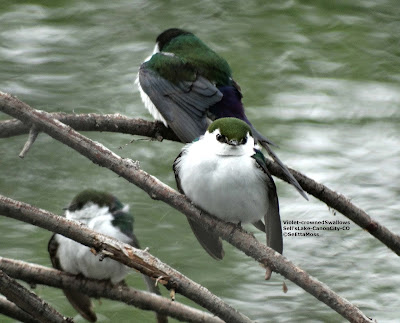Williamson's Sapsucker in mid-winter in Red Canyon Park
I drove up to Red Canyon Park yesterday morning and walked too close to a tree with this female Willamson's Sapsucker who flushed literally over my shoulder. She is so well camouflaged I had no idea she was in the tree until she flew out.
I have in the past noticed hundreds of sap wells drilled by sapsuckers in the pinyon and juniper trees in Red Canyon Park just north of Canon City but though I have birded there in spring, summer and fall I have never spotted a sapsucker in the park. Since I found the first Williamson's Sapsucker in Canon City in the winter more than a decade ago many sapsucker have been documented overwintering in the Canon City area, a few other areas in the region, while most migrate south to New Mexico or further for the winter. Though one bird does not confirm that this species overwinters in the pinyon juniper habitat of this park, it certainly seems most likely.
She returned a short time later and I watched her drilling into the deeply pocketed wood of two junipers and a pinyon tree, all within about 75 feet of each other. I drove up to Red Canyon Park yesterday morning and walked too close to a tree with this female Willamson's Sapsucker who flushed literally over my shoulder. She is so well camouflaged I had no idea she was in the tree until she flew out.
As I have experienced with other Williamson's Sapsuckers, this one was not very tolerant of my presence and the slight sounds coming from my camera which caused her to flush from the tree she was drilling. So I had to get into my car and finish my observation and photography using it as a blind.
The juniper below is the tree in which I took all but the very top photo of this bird. Interestingly some of the time when she was drilling in this or the other juniper while I observed I did not hear the tapping noise so common from sapsuckers when they drill into a tree. I suspect it is due to the deep crevices in the bark in some way muffling the noise.
Almost all of the trees, both junipers and pinyon pines, are marked with at least dozens and usually hundreds of sap wells. The very bottom pic is the pinyon pine I observed this sapsucker drilling and it shows the fresh sap wells. SeEtta
I have in the past noticed hundreds of sap wells drilled by sapsuckers in the pinyon and juniper trees in Red Canyon Park just north of Canon City but though I have birded there in spring, summer and fall I have never spotted a sapsucker in the park. Since I found the first Williamson's Sapsucker in Canon City in the winter more than a decade ago many sapsucker have been documented overwintering in the Canon City area, a few other areas in the region, while most migrate south to New Mexico or further for the winter. Though one bird does not confirm that this species overwinters in the pinyon juniper habitat of this park, it certainly seems most likely.
She returned a short time later and I watched her drilling into the deeply pocketed wood of two junipers and a pinyon tree, all within about 75 feet of each other. I drove up to Red Canyon Park yesterday morning and walked too close to a tree with this female Willamson's Sapsucker who flushed literally over my shoulder. She is so well camouflaged I had no idea she was in the tree until she flew out.
As I have experienced with other Williamson's Sapsuckers, this one was not very tolerant of my presence and the slight sounds coming from my camera which caused her to flush from the tree she was drilling. So I had to get into my car and finish my observation and photography using it as a blind.
The juniper below is the tree in which I took all but the very top photo of this bird. Interestingly some of the time when she was drilling in this or the other juniper while I observed I did not hear the tapping noise so common from sapsuckers when they drill into a tree. I suspect it is due to the deep crevices in the bark in some way muffling the noise.
Almost all of the trees, both junipers and pinyon pines, are marked with at least dozens and usually hundreds of sap wells. The very bottom pic is the pinyon pine I observed this sapsucker drilling and it shows the fresh sap wells. SeEtta









Comments